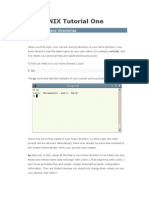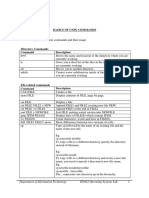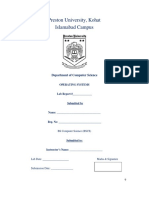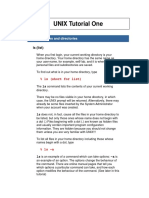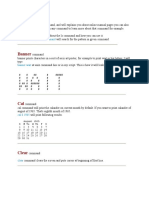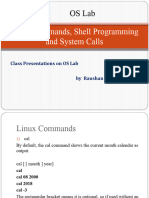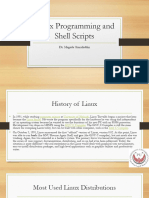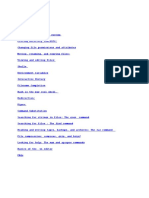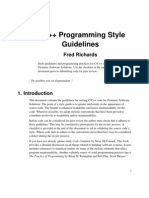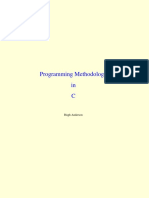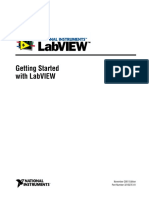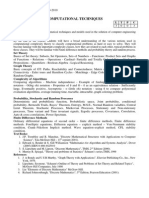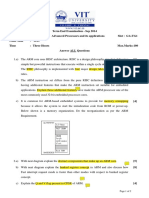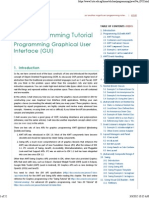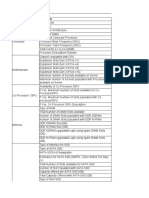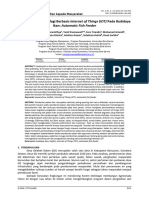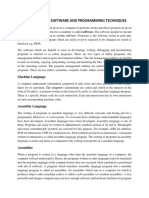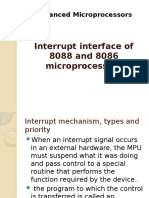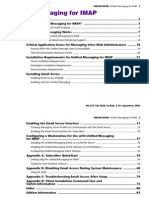UNIX and LINUX commands
P Chitra
AP, SENSE, VIT.
9/16/2015
�Chapter 1
Listing files and directories
ls (list)
When you first login, your
current working directory is
your home directory.
Your home directory has the
same name as your username, for example, shriram,
and it is where your personal
files and subdirectories are
saved.
To find out what is in your
home directory, type
% ls
The ls command ( lowercase L
and lowercase S ) lists the
contents of your current
working directory.
9/16/2015
�Listing files and directories
ls does not, in fact, cause all the
files in your home directory to be
listed, but only those ones whose
name does not begin with a dot (.)
Files beginning with a dot (.) are
known as hidden files and usually
contain important program
configuration information.
They are hidden because you
should not change them unless
you are very familiar with UNIX!!!
To list all files in your home
directory including those whose
names begin with a dot, type
% ls -a
As you can see, ls -a lists files that
are normally hidden.
9/16/2015
�Making Directories
mkdir (make directory)
We will now make a
subdirectory in your home
directory to hold the files
you will be creating and
using in the course of this
tutorial. To make a
subdirectory called
unixstuff in your current
working directory type
% mkdir unixstuff
To see the directory you
have just created, type
% ls
9/16/2015
�Making Directories
9/16/2015
�Making Directories Little Play
9/16/2015
�Change Directory (cd)
Cd ~ will also take you to
your home directory
9/16/2015
�The parent directory (..)
(..) means the parent of the current
directory, so typing
% cd ..
will take you one directory up the hierarchy
(back to your home directory). Try it now.
9/16/2015
�pwd (print working directory)
Pathnames enable you to work
out where you are in relation to
the whole file-system. For
example, to find out the absolute
pathname of your home-directory,
type cd to get back to your homedirectory and then type
% pwd
The full pathname will look
something like this /home/its/ug1/ee51vn
which means that ee51vn (your
home directory) is in the subdirectory ug1 (the group
directory),which in turn is located
in the its sub-directory, which is in
the home sub-directory, which is
in the top-level root directory
called " / " .
NOTE: / is called as mount point
9/16/2015
�Here you
9/16/2015
10
�Chapter 2
Copying Files
9/16/2015
11
�Removing Files and Directories
To delete (remove) a
file, use the rm
command.
% rm tempfile.txt
9/16/2015
12
�Displaying the contents of a file on
the screen
clear (clear screen)
Before you start the next section, you may
like to clear the terminal window of the
previous commands so the output of the
following commands can be clearly
understood.
At the prompt, type
% clear
This will clear all text and leave you with the
% prompt at the top of the window.
9/16/2015
13
�Let me catch the CATs HEAD and
TAIL
cat (concatenate)
The command cat can be used to display
the contents of a file on the screen. Type:
% cat science.txt
If the file is longer than the size of the
window, so it scrolls past making it
unreadable.
less
The command less writes the contents of
a file onto the screen a page at a time.
Type
% less science.txt
Press the [space-bar] if you want to see
another page, and type [q] if you want to
quit reading. As you can see, less is used
in preference to cat for long files.
head
The head command writes the first ten
lines of a file to the screen.
First clear the screen then type
% head science.txt
Then type
% head -5 science.txt
What difference did the -5 do to the head
command?
tail
The tail command writes the last ten lines
of a file to the screen.
Clear the screen and type
% tail science.txt
ANSWER THIS NOW:
Q. How can you view the last 15 lines of
the file?
9/16/2015
14
�The CAT has grown bigger
9/16/2015
15
�Lets Count - WC
wc (word count)
A handy little utility is the wc
command, short for word count.
To do a word count on
science.txt, type
% wc -w science.txt
To find out how many lines the file
has, type
% wc -l science.txt
9/16/2015
grep () - "global regular expression
printer"
grep is one of many standard
UNIX utilities. It searches files for
specified words or patterns. First
clear the screen, then type
% grep science science.txt
16
�Here you
9/16/2015
17
�Chapter 3
Re direction
Most processes initiated by UNIX commands write to the standard output (that is,
they write to the terminal screen), and many take their input from the standard input
(that is, they read it from the keyboard). There is also the standard error, where
processes write their error messages, by default, to the terminal screen.
We have already seen one use of the cat command to write the contents of a file to
the screen.
Now type cat without specifying a file to read
% cat
Then type a few words on the keyboard and press the [Return] key.
Finally hold the [Ctrl] key down and press [d] (written as ^D for
short) to end the input.
What has happened?
If you run the cat command without specifying a file to read, it reads
the standard input (the keyboard), and on receiving the 'end of file'
(^D), copies it to the standard output (the screen).
In UNIX, we can redirect both the input and the output of
commands.
9/16/2015
18
�Re - direction
We will now use the cat command to join (concatenate) list1 and list2
into a new file called biglist. Type
% cat list1 list2 > biglist
What this is doing is reading the contents of list1 and list2 in turn,
then outputing the text to the file biglist
To read the contents of the new file, type % cat biglist
9/16/2015
19
�Let the water flow - PIPES
To see who is on the system with you, type
% who
One method to get a sorted list of names is to type,
% who > names.txt
% sort < names.txt
What you really want to do is connect the output of the
who command directly to the input of the sort command.
This is exactly what pipes do. The symbol for a pipe is
the vertical bar |
For example, typing
% who | sort
will give the same result as above, but quicker and
cleaner.
To find out how many users are logged on, type
% who | wc -l
9/16/2015
20
�Contd.,
9/16/2015
21
�Here you
9/16/2015
22
�Chapter 4
Few New Intros
9/16/2015
23
�Wildcards
The * wildcard
The character * is called a wildcard, and will
match against none or more character(s) in a
file (or directory) name. For example, in your
directory, type
% ls list*
This will list all files in the current directory
starting with list....
Try typing
% ls *list
This will list all files in the current directory
ending with ....list
9/16/2015
24
�Wildcards
The ? wildcard
The character ? will match exactly one
character.
So ?ouse will match files like house and
mouse, but not grouse.
Try typing
% ls ?list
9/16/2015
25
�Filename conventions
9/16/2015
26
�MAN can HELP you to know
WHATIS this! - On-line Manuals
There are on-line manuals which gives information about
most commands. The manual pages tell you which options a
particular command can take, and how each option modifies
the behaviour of the command. Type man command to read
the manual page for a particular command.
For example, to find out more about the wc (word count)
command, type
% man wc
Alternatively
% whatis wc
gives a one-line description of the command, but omits any
information about options etc.
And u can do man man
9/16/2015
27
�Are you appropriate?
Apropos
When you are not sure of the exact name of a command,
% apropos keyword
will give you the commands with keyword in their manual
page header. For example, try typing
% apropos date
9/16/2015
28
�Here you
9/16/2015
29
�Chapter 5
File system security (access
rights)
In your directory, type
% ls -l (l for long listing!)
9/16/2015
30
�File system security (access
rights)
Access rights on files.
r (or -), indicates read permission (or otherwise), that is, the presence or absence of
permission to read and copy the file
w (or -), indicates write permission (or otherwise), that is, the permission (or otherwise) to
change a file
x (or -), indicates execution permission (or otherwise), that is, the permission to execute a
file, where appropriate
Access rights on directories.
r allows users to list files in the directory;
w means that users may delete files from the directory or move files into it;
x means the right to access files in the directory. This implies that you may read files in the
directory provided you have read permission on the individual files.
9/16/2015
31
�Changing access rights Lets
Change
chmod (changing a file mode)
Only the owner of a file can use
chmod to change the permissions
of a file. The options of chmod are
as follows
9/16/2015
32
�Changing access rights Lets
Change
For example, to remove read write and execute permissions on the
file biglist for the group and others, type
% chmod go-rwx biglist
This will leave the other permissions unaffected.
To give read and write permissions on the file biglist to all,
% chmod a+rw biglist
9/16/2015
33
�Processes and Jobs
A process is an executing program identified by a
unique PID (process identifier). To see information
about your processes, with their associated PID and
status, type
% ps
A process may be in the foreground, in the
background, or be suspended. In general the shell
does not return the UNIX prompt until the current
process has finished executing.
Some processes take a long time to run and hold up
the terminal.
Backgrounding a long process has the effect that the
UNIX prompt is returned immediately, and other tasks
can be carried out while the original process continues
executing.
34
9/16/2015
�Processes and Jobs
Running background processes
To background a process, type an & at the end of the command line. For
example, the command sleep waits a given number of seconds before
continuing. Type
% sleep 10
This will wait 10 seconds before returning the command prompt %. Until the
command prompt is returned, you can do nothing except wait.
To run sleep in the background, type
% sleep 10 &
[1] 6259
The & runs the job in the background and returns the prompt straight away,
allowing you do run other programs while waiting for that one to finish.
The first line in the above example is typed in by the user; the next line,
indicating job number and PID, is returned by the machine.
The user is be notified of a job number (numbered from 1) enclosed in
square brackets, together with a PID and is notified when a background
process is finished.
Backgrounding is useful for jobs which will take a long time to complete.
9/16/2015
35
�Backgrounding a current
foreground process
You can suspend the process running in
the foreground by typing ^Z, i.e.hold down
the [Ctrl] key and type [z]. Then to put it in
the background, type
% bg
Note: do not background programs that
require user interaction e.g. vi
9/16/2015
36
�listing suspended and
background processes
When a process is running, backgrounded or suspended, it
will be entered onto a list along with a job number. To
examine this list, type
% jobs
An example of a job list could be
[1] Suspended sleep 1000
[2] Running netscape
[3] Running matlab
To restart (foreground) a suspended processes, type
% fg %jobnumber
For example, to restart sleep 1000, type
% fg %1
Typing fg with no job number foregrounds the last suspended
process.
9/16/2015
37
�Killing a process
kill (terminate or signal a
process)
It is sometimes necessary to kill a process
(for example, when an executing program
is in an infinite loop)
To kill a job running in the foreground, type
^C (control c). For example, run
% sleep 100
^C
9/16/2015
38
�ps (process status)
Alternatively, processes can be killed by finding their process
numbers (PIDs) and using kill PID_number
% sleep 1000 &
% ps
PID TT S TIME COMMAND
20077 pts/5 S 0:05 sleep 1000
21563 pts/5 T 0:00 netscape
21873 pts/5 S 0:25 nedit
To kill off the process sleep 1000, type
% kill 20077
and then type ps again to see if it has been removed from
the list.
If a process refuses to be killed, uses the -9 option, i.e. type
% kill -9 20077
Note: It is not possible to kill off other users' processes !!!
9/16/2015
39
�Here U
<-- (Lets Recap here)
9/16/2015
40
�CHAPTER 6
FEW MORE USEFUL COMMANDS
quota
Uname a
All students are allocated a
certain amount of disk
space on the file system for
their personal files, usually
about 100Mb. If you go over
your quota, you are given 7
days to remove excess
files.
To check your current quota
and how much of it you
have used, type
% quota -v
This will let u know which version
of linux are u using!
du
The du command outputs the
number of kilobyes used by each
subdirectory. Useful if you have
gone over quota and you want to
find out which directory has the
most files. In your home-directory,
type
% du -s *
The -s flag will display only a
summary (total size) and the *
means all files and directories.
9/16/2015
41
�Contd.,
gzip
This reduces the size of a file,
thus freeing valuable disk space.
For example, type
% ls -l science.txt
and note the size of the file using
ls -l . Then to compress
science.txt, type
% gzip science.txt
This will compress the file and
place it in a file called
science.txt.gz
To see the change in size, type ls
-l again.
To expand the file, use the gunzip
command.
% gunzip science.txt.gz
9/16/2015
zcat
zcat will read gzipped files without
needing to uncompress them first.
% zcat science.txt.gz
If the text scrolls too fast for you,
pipe the output though less .
% zcat science.txt.gz | less
diff
This command compares the
contents of two files and displays
the differences. Suppose you
have a file called file1 and you
edit some part of it and save it as
file2. To see the differences type
% diff file1 file2
42
�History is important
% history (show command history list)
% !! (recall last command)
% !-3 (recall third most recent command)
% !5 (recall 5th command in list)
% !grep (recall last command starting with
grep)
You can increase the size of the history
buffer by typing
% set history=100
9/16/2015
43
�Chapter 7
We are nearing to end
environment Variables
An example of an environment variable is the OSTYPE
variable. The value of this is the current operating system you
are using. Type
% echo $OSTYPE
More examples of environment variables are
USER (your login name)
HOME (the path name of your home directory)
HOST (the name of the computer you are using)
ARCH (the architecture of the computers processor)
DISPLAY (the name of the computer screen to display X
windows)
PRINTER (the default printer to send print jobs)
PATH (the directories the shell should search to find a
command)
9/16/2015
44
�Finding out the current values of these
variables.
ENVIRONMENT variables are set using
the setenv command, displayed using the
printenv or env commands, and unset
using the unsetenv command.
To show all values of these variables, type
% printenv | less
9/16/2015
45
�What is Process??
Let`s have some food for
brain
46
46
�What is Process?? - Most important
thing to know
Process is any kind of program or task
carried out by your PC. For e.g. $ ls -lR , is
command or a request to list files in a
directory and all subdirectory in your current
directory. It is a process.
A process is program (command given by
user) to perform some Job.
In Linux when you start process, it gives a
number (called PID or process-id), PID starts
from 0 to 65535.
47
47
�Contd.,
$ ls / -R | wc -l
This command will take lot of time to search all files on
your system. So you can run such command in
Background or simultaneously by giving command like
$ ls / -R | wc -l &
The ampersand (&) at the end of command tells shells
start command (ls / -R | wc -l) and run it in background
takes next command immediately.
An instance of running command is called process and
the number printed by shell is called process-id (PID),
this PID can be use to refer specific running process.
48
48
�Process Related Commands
NOTE that you can only kill process which are created by yourself. A
Administrator can almost kill 95-98% process. But some process can
not be killed, such as VDU Process.
49
49
�Advanced Commands in
Alphabetical Order
1. Alias
9/16/2015
50
�AWK
awk command is
used to manipulate
the text. This
command checks
each line of a file,
looking for patterns
that match those
given on the
command line.
9/16/2015
51
�AWK Slight Improvement
9/16/2015
52
�Bc Basic Calculator
shri@ubuntu:~$ bc -l
bc 1.06.94
Copyright 1991-1994, 1997, 1998, 2000, 2004, 2006 Free Software
Foundation, Inc.
This is free software with ABSOLUTELY NO WARRANTY.
For details type `warranty'.
bc command is used for command
line calculator. It is similar to basic
calculator. By using which we can
do basic mathematical calculations.
1+2
3
3+2
5
shri@ubuntu:~$ cat > file1.txt
1+2
quit
quit
shri@ubuntu:~$ bc
bc 1.06.94
Copyright 1991-1994, 1997, 1998, 2000, 2004, 2006 Free Software
Foundation, Inc.
This is free software with ABSOLUTELY NO WARRANTY.
For details type `warranty'.
9*2
18
9+2
11
10-10
0
shri@ubuntu:~$ bc file1.txt
bc 1.06.94
Copyright 1991-1994, 1997, 1998, 2000, 2004,
2006 Free Software Foundation, Inc.
This is free software with ABSOLUTELY NO
WARRANTY.
For details type `warranty'.
3
shri@ubuntu:~$
Quit - Will take you out of the calculator.
9/16/2015
53
�Bg and jobs
It is helpful to list the jobs that are running in the background.
shri@ubuntu:~$ jobs
[1]+ Running
gedit file1.txt &
shri@ubuntu:~$ bg
bash: bg: job 1 already in background
shri@ubuntu:~$
9/16/2015
54
�Lets zip it
bzip2 COMMAND:
bzip2 linux command is used to compress
the file. Each file is replaced by a
compressed version of itself with .bz2
extension
- 1 Performs fast compression,creating a
relatively large files. This is an important
option over here
When the file is compressed with -1 the
size was 17706 bytes and now the
filesize is 2394 bytes. The 9 makes best
compression but the default is 6.
9/16/2015
Now Zipping
shri@ubuntu:~$ cat file1.txt
1+2
Quit
shri@ubuntu:~$ bzip2 -c -1 file1.txt > file1.txt.bz2
shri@ubuntu:~$ ls -lrt | grep *.bz2
-rw-r--r-- 1 shri shri 54 2010-03-30 02:42 file1.txt.bz2
shri@ubuntu:~$
Now Zipping Better
$ bzip2 -c -9 hiox.txt > hscripts.txt.bz2
$ ls -l
-rw-rw-r-- 1 hiox hiox 9150000 Sep 26 18:37 hiox.txt
-rw-rw-r-- 1 hiox hiox 17706 Sep 27 12:38 hiox.txt.bz2
-rw-rw-r-- 1 hiox hiox 2394 Sep 27 13:01 hscripts.txt.bz2
Shriram K Vasudevan, LINUX @ VIT
55
�Lets Catch C
CALENDAR - CAL
9/16/2015
56
�C - Here
We have spent time
on Cat, cd, cp, clear,
Cal and chmod.
So let us see rest of
the advanced
commands here.
9/16/2015
57
�Going advanced
chattr COMMAND:
chattr command is used to change the file attributes.
This is an admin command. Root user only can change the
file attributes/Process.
+i Make the file as Read-Only.
-i Remove the Read-Only.
+a Can't open file for writing.
-a Open file for writing.
$chattr +a file1.txt
$chattr: Operation not permitted while setting flags on file1.tx
As this is an Admin commands.. We got the above message!
9/16/2015
58
�Going advanced
9/16/2015
chgrp COMMAND:
chgrp command is used to
change the group of the file or
directory. This is an admin
command. Root user only can
change the group of the file or
directory.
This is again a privileged
command. So cant make use of it.
59
�Going advanced
chown COMMAND:
chown command is used to change the owner / user of the file or directory. This is
an admin command, root user only can change the owner of a file or directory.
SYNTAX:
The Syntax is chown [options] newowner filename/directoryname
The owner of the file1.txt' file is shri, Change to new user root.
-rw-r--r-- 1 shri shri 12 2010-03-30 02:34 file1.txt
shri@ubuntu:~$ chown root file1.txt
chown: changing ownership of `file1.txt': Operation not permitted
9/16/2015
60
�Cmp command
cmp COMMAND:
cmp linux command
compares two files and tells
you which line numbers are
different.
SYNTAX:
The Syntax is
cmp [options..] file1 file2
OPTIONS:
- c Output differing bytes as
characters.
- l Print the byte number
(decimal) and the differing byte
values (octal) for each
difference.
- s Prints nothing for differing
files, return exit status only.
9/16/2015
61
�cut
cut COMMAND:
cut command is used to cut
out selected fields of each line
of a file. The cut command
uses delimiters to determine
where to split fields.
SYNTAX:
The Syntax is
cut [options]
OPTIONS:
-c Specifies character
positions. -b Specifies byte
positions.
9/16/2015
EXAMPLE:
Lets create a file file1.txt
and let it have the following
data:
Data in file1.txt
This is, an example
program,for cut command.
cut -c1-3 text.txt
Output:
Thi
Cut the first three letters from
the above line.
62
�LETS GET INTO D
date command
date
The above command will
print
Wed Jul 23 10:52:34 IST
2008
9/16/2015
df COMMAND:
df command is used to report how much free disk space is
available for each mount you have. The first column show the name
of the disk partition as it appears in the /dev directory. Subsequent
columns show total space, blocks allocated and blocks available.
shri@ubuntu:~$ df
Filesystem
1K-blocks
Used Available Use% Mounted on
/dev/sda1
4878132 2476452 2153880 54% /
udev
254668
224 254444 1% /dev
none
254668
180 254488 1% /dev/shm
none
254668
92 254576 1% /var/run
none
254668
0 254668 0% /var/lock
none
254668
0 254668 0% /lib/init/rw
shri@ubuntu:~$
63
�LETS GET INTO D
shri@ubuntu:~$ du
76
./.gconfd
8
./.cache/gedit
28
./.cache
116 ./.mozilla/firefox/day8z6r3.default/Cache
4
./.mozilla/firefox/day8z6r3.default/extensions
12
./.mozilla/firefox/day8z6r3.default/chrome
12
./.mozilla/firefox/day8z6r3.default/bookmarkbackups
3932 ./.mozilla/firefox/day8z6r3.default
3940 ./.mozilla/firefox
4
./.mozilla/extensions/{ec8030f7-c20a-464f-9b0e-13a3a9e97384}
8
./.mozilla/extensions
3952 ./.mozilla
4
./.gnome2_private
4
./t12
12
./.update-manager-core
8
./.gnome2/gedit
4
./.gnome2/nautilus-scripts
4
./.gnome2/panel2.d/default/launchers
8
./.gnome2/panel2.d/default
12
./.gnome2/panel2.d
8
./.gnome2/keyrings
28
./.gnome2/accels
64
./.gnome2
4
./Documents
20
./.thumbnails/normal
24
./.thumbnails
0
./.gvfs
4
./.update-notifier
4
./.config/gnome-session/saved-session
8
./.config/gnome-session
9/16/2015
du command is used to
report how much disk space
a file or directory occupies.
64
�E Only Echo!
9/16/2015
65
�F
Fg:
fg command is used to place a job in foreground.
Run some process in background.Use fg the
process will be brought to foreground.
shri@ubuntu:~$ gedit file1.txt &
[1] 4970
shri@ubuntu:~$ fg 1
gedit file1.txt
9/16/2015
66
�F - Finger
shri@ubuntu:~$ finger
Login Name
Tty
Idle Login Time Office Office Phone
shri
shriram tty7
4d Mar 26 20:02 (:0)
shri
shriram pts/0
Mar 26 21:19 (:0.0)
shri@ubuntu:~$
shri@ubuntu:~$ finger shri
Login: shri
Name: shriram
Directory: /home/shri
Shell: /bin/bash
On since Fri Mar 26 20:02 (PDT) on tty7 from :0
4 days 11 hours idle
On since Fri Mar 26 21:19 (PDT) on pts/0 from :0.0
No mail.
No Plan.
9/16/2015
finger command displays the user's login name, real
name, terminal name and write status (as a ''*'' after the
terminal name if write permission is denied), idle time,
login time, office location and office phone number
67
�File..
file COMMAND:
file command tells you if the object you are
looking at is a file or a directory.
File * will list you the types of files available in that
system.
shri@ubuntu:~$ file *.txt
f1.txt:
ASCII text
f2.txt:
ASCII text
file1.txt: ASCII text
file2.txt: ASCII text
file_t1.txt: empty
file_t2.txt: empty
file.txt: ASCII text
linux.txt: ASCII text
result.txt: ASCII text
shriram.txt: ASCII text
test2.txt: ASCII text
9/16/2015
68
�You are free after this slide.
free COMMAND:
free command displays information about free and used
memory on the system.
shri@ubuntu:~$ free
total
used
free shared
Mem:
509336 480580
28756
-/+ buffers/cache: 150504 358832
Swap:
281096
48 281048
shri@ubuntu:~$
9/16/2015
buffers cached
0 140528 189548
69
�G
All these are used to Add groups,
Delete Groups, Modify an Existing
group etc., as all these are admin
commands you will end up in not
having permission for executing these
commands..
Typing groups will get u the details of all the available groups in you
system.
shri@ubuntu:~$ groups
shri adm dialout cdrom plugdev lpadmin admin sambashare
9/16/2015
70
Can We Halt? System Related
Commands
To halt the system:
halt
This command is similar to poweroff, which
shutdown the system.
To Poweroff the system:
poweroff
Poweroff command used for turnoff the
system.
To reboot the system:
reboot
Reboot command used for reboots/restarts the
system.
9/16/2015
71
�Host
host COMMAND:
host command is used to find the ip address
of the given domain name and also prints the
domain name for the given ip.
shri@ubuntu:~$ host vit.ac.in
vit.ac.in has address 192.168.64.3
vit.ac.in mail is handled by 5 alt1.aspmx.l.google.com.\032.
vit.ac.in mail is handled by 5 alt2.aspmx.l.google.com.
vit.ac.in mail is handled by 10 aspmx2.googlemail.com.\032.
vit.ac.in mail is handled by 10 aspmx3.googlemail.com.\032.
vit.ac.in mail is handled by 10 aspmx4.googlemail.com.\032.
vit.ac.in mail is handled by 10 aspmx5.googlemail.com.\032.
vit.ac.in mail is handled by 1 aspmx.l.google.com.\032.
shri@ubuntu:~$ host yahoo.co.in
yahoo.co.in has address 68.180.206.184
yahoo.co.in has address 206.190.60.37
yahoo.co.in mail is handled by 10 in32.mxauth.yahoo.com.
shri@ubuntu:~$ host 68.180.206.184
184.206.180.68.in-addr.arpa domain name pointer w2.rc.vip.sp1.yahoo.com.
shri@ubuntu:~$
9/16/2015
72
�Host id and Host Name
hostid COMMAND:
hostid command prints
the numeric identifier or id
of the current host in
hexadecimal.
shri@ubuntu:~$ hostid
007f0101
shri@ubuntu:~$
SYNTAX:
The Syntax is
hostid
hostid COMMAND:
hostid command prints the
numeric identifier or id of the
current host in hexadecimal.
SYNTAX:
The Syntax is
hostid
9/16/2015
shri@ubuntu:~$ hostname
UBUNTU
shri@ubuntu:~$
73
�id
id COMMAND:
id command prints the effective(current) and real userid(UID)s
and groupid(GID)s.
SYNTAX:
The Syntax is
id
shri@ubuntu:~$ id
uid=1000(shri) gid=1000(shri)
groups=4(adm),20(dialout),24(cdrom),46(plugdev),104(lpadmin),1
15(admin),120(sambashare),1000(shri)
9/16/2015
74
�info
info command is used to display
the readable online documentation
for the specified command .
Typing just info will lead you
screen to be filled with hell a lot of
data!
IFCONFIG
ifconfig command displays information about the
network interfaces attached to the system and
also used to configure the network interface.
shri@ubuntu:~$ info
man
shri@ubuntu:~$ info cp
To Assign IP address to Network Interface[Ethernet
Card]:
ifconfig eth0 192.168.0.12 up
The above command will Assign IP address
192.168.0.12 to Ethernet card with name eth0.
To inactivate the Network Interface[Ethernet Card]:
ifconfig eth0 down
The above command inactivates the ethernet card.
9/16/2015
75
�netstat
nestat command displays statistics
information and current state of network
connections, protocol, ports/ sockets and
devices.
9/16/2015
unix 3
[]
STREAM
CONNECTED 9803 @/tmp/dbus3Imoh4QFZa
unix 3
[]
STREAM
CONNECTED 9802
unix 3
[]
STREAM
CONNECTED 9801 /tmp/orbitshri/linc-7b7-0-28f9f13a74fe6
unix 3
[]
STREAM
CONNECTED 9800
unix 3
[]
STREAM
CONNECTED 9799 /tmp/orbitshri/linc-773-0-455a56f8d87af
unix 3
[]
STREAM
CONNECTED 9796
unix 3
[]
STREAM
CONNECTED 9792 @/tmp/.X11unix/X0
unix 3
[]
STREAM
CONNECTED 9791
unix 3
[]
STREAM
CONNECTED 9790 /tmp/orbitshri/linc-7b6-0-3923529828c29
76
�route
route command displays
routing table resides in
kernel and also used to
modify the routing table.
The tables which specifies
how packets are routed to a
host is called routing table.
shri@ubuntu:~$ route n (Where n is net)
Kernel IP routing table
Destination Gateway
Genmask
Flags Metric Ref Use
Iface
192.168.98.0 0.0.0.0
255.255.255.0 U 1
0
0 eth0
0.0.0.0
192.168.98.2 0.0.0.0
UG 0
0
0 eth0
shri@ubuntu:~$
9/16/2015
77
�Yes Am Saying Bye
yes command repeatedly prints
the given string separated by a
space and followed by a newline
until it is killed. If no string is given,
it just prints 'y' repeatedly until it is
killed. It is normally used in
scripts, its output is piped to a
command or program that
prompts you to do this or that (do
you want to delete this file press
'y' or 'n')
9/16/2015
shri@ubuntu:~$ yes shriram | more
shriram
shriram
shriram
shriram
shriram
shriram
shriram
shriram
shriram
shriram
shriram
shriram
78
�Let me say bye to commands
here!
Itz your turn
9/16/2015
79





